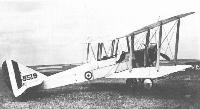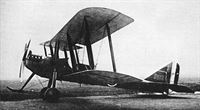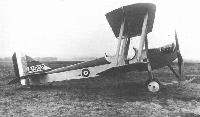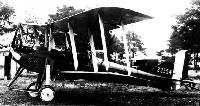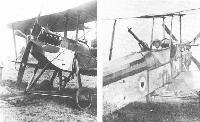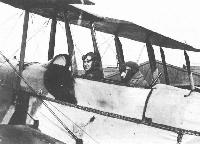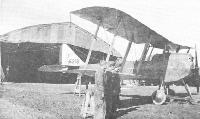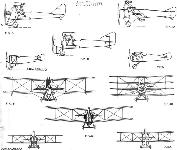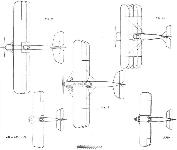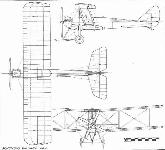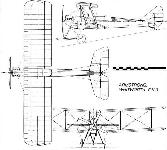В.Кондратьев Самолеты первой мировой войны
Цельнодеревянный двухстоечный биплан с полотняной обшивкой. Разработан главным конструктором фирмы Уитворт энд Компани (Ньюкастл) Фредериком Кольховеном для замены выпускавшегося на этой фирме разведчика RAF В.Е.2с. Кольховен решил создать аэроплан с тем же двигателем, но более простой и дешевый, а кроме того - обладающий повышенными летными данными. Инициатива получила поддержку, и работа была развернута в конце лета 1915 года.
Осенью поднялся в воздух первый прототип F.K.3. Как и у В.Е.2, кабина пилота на нем располагалась сзади, а летнаба - спереди. Вооружение отсутствовало. На серийных машинах пилот и летнаб поменялись местами (в дальнейшем такая схема размещения экипажа стала классической), а в задней кабине появилась пулеметная турель. Для повышения устойчивости увеличили площадь вертикального оперения. Помимо фирмы-разработчика, F.K.3 выпускали заводы компаний Мессье, Хьюлетт и Блондью. Всего построено около 500 экземпляров машины, получившей среди пилотов прозвище "Маленький Ак" (Little Ack).
Вопреки надеждам конструктора, F.K.3 уступал конкурентному В.Е.2с в скороподъемности и полезной нагрузке, однако имел превосходство по скорости и потолку. Самолет не попал на западноевропейские фронты, найдя лишь ограниченное применение в Македонии и на Среднем Востоке, где активность вражеских истребителей была довольно слабой. При этом для увеличения груза бомб F.K.3 обычно летали без стрелков и со снятым пулеметным вооружением. Большинство же "Литтл Аков" служило в учебных подразделениях.
ДВИГАТЕЛЬ
РАФ Ia, 90л.с.
ВООРУЖЕНИЕ
1 турельный "Льюис", 50 кг бомб.
ЛЕТНО-ТЕХНИЧЕСКИЕ ХАРАКТЕРИСТИКИ
Размах, м 12,22
Длина, м 8,84
Сухой вес, кг 629
Взлетный вес, кг 933
Скорость максимальная, км/ч 137
Время набора высоты, м/мин 1500/19
Потолок, м 3650
Показать полностью
O.Tapper Armstrong Whitworth Aircraft since 1913 (Putnam)
The Wartime Veterans
When Frederick Koolhoven joined Annstrong Whitworth in 1914 the works at Gosforth were being prepared for B.E.2c production and he concluded, after studying the official design, that it was unnecessarily difficult to build. He therefore straightway offered to design an aircraft which, without sacrifice of performance, would be easier to produce. Rather surprisingly, in view of their unshakable faith in the B.E.2c, the authorities agreed and, in August 1915, Koolhoven went ahead with the construction of the Armstrong Whitworth version, the F.K.3.
F.K.3
The F.K.3 bore an obvious resemblance to the B.E.2c, and it is evident that Koolhoven's ideas about improving the design were concerned mainly with the structural features; indeed, his aim was, among other things, to eliminate welding and intricate metal fittings. The F.K.3, like the B.E.2c, had a slender fuselage, high aspect ratio wings, and two-bay bracing; unlike the B.E, it had more dihedral on the top plane than on the bottom. The prototype, which was test-flown by Norman Spratt, was fitted with a 70 hp Renault engine, but production aircraft were powered by the RAF 1a of 90 hp. One F.K.3, No.5519, was tested in June 1916 with the more powerful RAF Ib engine, but the tests with this aircraft were plagued by constant engine failures due to faulty pistons.
Seating arrangements in the F.K.3 prototype followed the B.E.2c precedent of placing the observer in the front in a separate cockpit underneath the top wing, but this was later changed so that both crew members were accommodated in one large cockpit, with the observer at the back where he could use his Lewis gun with much greater effect. The rear portion of the long cockpit opening was shielded by side screens extending forward to the rearmost centre-section struts, giving from the side the appearance of two separate cockpits. All the earlier production aircraft with the observer's seat in front, of which there were twelve, were afterwards modified to reverse the crew positions. The undercarriage was of unusual design in that it employed oleo shock-absorbers mounted vertically on the sides of the fuselage from which struts extended down to the ends of a divided axle. A central skid extended forward from the axle to protect the propeller in the event of a tail-high landing.
No provision was made for a forward-firing gun, but the observer was provided with a Lewis gun mounted on a pillar behind his seat. As was the case with the B.E. aeroplanes, pilots used considerable ingenuity in attempts to equip themselves with some form of gun mounted to fire past the propeller, but none of the methods adopted was noticeably successful. External bomb racks fitted under the lower mainplane were capable of carrying bombs up to the weight of 112 lb but, because of weight limitations, it was usual to fly without the observer when bombs were carried.
An F.K.3, No.5552, with a 90 hp RAF la engine, was tested alongside a B.E.2c at the Central Flying School at Upavon in May 1916. The tests showed that the F.K.3 had a slightly better all-round performance and that it was lighter on the controls and more pleasant to handle. The report commented favourably on the crew positions, the roomy rear cockpit, and the ease of communication between the pilot and observer even without the use of a speaking tube; it criticized the positioning of control column and rudder bar and mentioned a draught in the cockpit coming from the fuselage openings at the junction of the undercarriage struts. In general the aircraft was considered to be well designed and easy to manufacture; it was simple to control and the oleo undercarriage was adjudged to be very good, although the long shock-absorber travel allowed the wingtips to touch the ground.
Early in the F.K.3 production run the RAF la engine became temporarily unobtainable and, at one time, according to a contemporary account, there were about a hundred complete aircraft awaiting engines. This may have been something of an exaggeration, but there is no doubt that a crisis had arisen and, in an endeavour to overcome it, some 120 hp Beardmore engines were sent to Newcastle in the hope that they might provide a satisfactory substitute.
The fitting of this engine into the F.K.3 presented many problems: the six-cylinder inline water-cooled Beardmore engine was some twenty inches longer than the RAF la and, even without the radiator, it was at least 90 lb heavier. To make room for the bigger engine, the fuel tank was removed from the fuselage and a larger, streamlined tank was located under the top centre section, together with a small header tank for the radiator. When installed, the engine sat high on its bearers and virtually blocked the forward view. The all-up weight of the aircraft was increased by about 400 lb, of which about 100 lb was accounted for by the additional fuel. To compensate for this extra load, the wing span of the aircraft was increased by two feet.
The first two Beardmore-powered F.K.3s (one of which was numbered 5528) were tested at Upavon in March 1916, and a report issued in May indicated that, although the climb performance was better than that of the RAF la version, the speed showed only a marginal improvement. That the Beardmore installation was not considered satisfactory is evident from the fact that all of the twelve aircraft so adapted were re-converted to standard as soon as RAF la engines again became available.
Precise production figures for the F.K.3 are difficult to ascertain because most of the official records of the time refer indiscriminately to Armstrong Whitworth biplanes without making any distinction between the F.K.3 and the F.K.8 which followed it. It is known that the War Office ordered one hundred and fifty F.K.3s from Armstrong Whitworth in 1915 and that the production rate is said to have reached 35 to 45 aircraft a month. In addition, orders for three hundred and fifty F.K.3s were placed with Hewlett & Blondeau of Luton, in Bedfordshire, a firm formed before the war by Gustav Blondeau, an early French aviator, and Mrs Maurice Hewlett, the wife of the author and herself the first British woman pilot.
In spite of the fact that the F.K.3 was clearly a better proposition than the B.E.2c, if only because it could defend itself more adequately if attacked from the rear, it seems that the type saw no active service on the Western Front, and the only operational unit that used it was No. 47 Squadron which served in Salonika from September 1916 until the end of the war. In that theatre the F.K.3s gave excellent service, performing a variety of duties including ground straffing, artillery spotting and bombing.
At home, the F.K.3 was used extensively for training, for which role its ease of handling and its ability to perform aerobatics made it eminently suitable, and it was probably the best of the British trainers until the arrival of the Avro 504. It was also used for observer training at the observer and air gunnery schools at Dymchurch, Hythe, Stirling and Turnberry. An F.K.3 was used as a personal transport by Major-General Sir Sefton Brancker, later to become the first Director General of Civil Aviation. He was a brave and resourceful man but a notoriously poor pilot, and his choice of the F.K.3 was a tribute to its ease of handling.
At the end of the war, in November J918, there were sixty-two F.K.3s still serving with the RAF, fifty-three at home, mostly based at flying schools, and nine in the Middle East. After the war only four found their way on to the civil register: G-EABY (ex B9629) and G-EABZ (ex B9518) which operated from Porthcawl, in South Wales, flown by E. D. C. Heme. Another, G-EAEU (ex B9612), was owned by the Kingsbury Aviation Co Ltd, but was crashed after a few months of civilian life. Finally, there was G-EALK (ex B9603) which was registered in the name of L. G. Lowe and held a certificate of airworthiness until September 1920.
A noticeable feature of the F.K.3 was an engine cowling panel carrying the initials 'AW'. These were not merely painted on but heavily embossed into the metal. As a result, perhaps not surprisingly, the aircraft soon became known, in the vernacular of the day, as the 'Ack·W' and, when its successor, the F.K.8, appeared with similar embellishment, it inevitably became another 'Ack-W': from then on the two aircraft were invariably referred to as the 'Little Ack' and the 'Big Ack'.
F.K.3
Dimensions: Span 40 ft (12.19 m); length 29 ft (8.84 m); height 11 ft 11 in (3.63 m); wing area 457 sq ft (42.46 sq m)
90hp RAF 1A 120 hp Beardmore
Max weight: 2,056 lb (933 kg) 2,447 lb (1,110 kg)
Empty weight: 1,386 lb (629 kg) 1,682 lb (763 kg)
Max speed
Sea level: 89 mph (143 km/hr) 91 mph (146 km/hr)
6,500 ft (1,981 m) 81 mph (130 km/hr) 84 mph (135 km/hr)
Stalling speed: 48 mph (77 km/hr) 56 mph (90 km/hr)
Climb
to 6,500 ft(1,981 m): 26.5 min 19 min
to 10,000 ft(3.048 m): 48.9 min 35 min
Service ceiling: 12,000 ft(3,658 m) 12,000 ft(3.658 m)
Endurance: 3 hr 3 hr
Показать полностью
F.Manson British Bomber Since 1914 (Putnam)
Armstrong, Whitworth F.K.2 and F.K.3
The old-established engineering company of Sir W G Armstrong, Whitworth & Co Ltd had tentatively entered the aircraft industry in 1910 with the rebuilding of a crashed Farman, and two years later began manufacturing ABC engines to the design of Granville Bradshaw. Expansion and diversification in the aircraft business followed in 1913 with airship manufacture at Selby in Yorkshire, and the production of aeroplanes at Gosforth, Newcastle-upon-Tyne. The latter business commenced with the acquisition of the services o f the Dutchman, Frederick Koolhoven, as aeroplane designer.
Early work included War Office contracts for the manufacture of B.E.2As, 2Bs and 2Cs, delivery of which began in 1914, and it was during the production of these aircraft that Koolhoven in March 1915 devised means by which the B.E.2C's structure might be simplified for ease of manufacture. The new design was tendered to the War Office and met with general approval, this leading to the raising of a small exploratory production contract for seven trials aircraft, designated the F.K.2, in August that year. Koolhoven's proposals were vindicated and rewarded by contracts for fairly large-scale production - by the standards of the time although the War Office maintained a stipulation that the production F.K.3 should not compete seriously with the Government Factory's B.E.2C, a policy that would in due course contribute to a serious breakdown in relations between the commercial aircraft manufacturers and the Service authorities.
The F.K.2 differed principally in almost completely eliminating welded joints and complex metal components in the airframe, and featured greater dihedral on the upper wing than on the B.E.2C. The prototype, probably first flown in September or October 1915 by Norman Pratt, was powered by the 70hp Renault, but subsequent aircraft were fitted with 90hp R.A.F. 1A engines. A generally popular and ingenious feature was the oleo-sprung undercarriage, the vertical shock absorbers being set into the sides of the fuselage. The cockpit arrangement of the trials F.K.2s followed that of the B.E.2C in that the pilot occupied the rear position, with the gunner in front; however, owing to the difficulty the gunner experienced in aiming and firing his gun, all subsequent production F.K.3s featured these cockpits reversed, enabling the gunner/observer to provide a more effective defence to the rear.
A single 100 lb or 112 lb bomb could be carried beneath the fuselage, although this precluded the carrying of the gunner owing to the limited engine power available. Alternatively, up to six 16 lb anti-personnel bombs could be attached to underwing racks.
It is said that a temporary shortage of R.A.F. 1A engines led to the fitting of the larger and heavier 120hp Beardmore engine in a number of F.K.3s early in 1916, but this was not considered satisfactory owing largely to a deterioration in handling qualities, and the aircraft reverted to standard when availability of the R.A.F. engine was restored.
Despite returning a slightly better performance than the R.A.F. B.E.2C, the F.K.3 did not see any active service on the Western Front, being delivered instead to No 47 Squadron at Beverley in Yorkshire in March 1916, and accompanying it to Salonika in September that year. Local field reconnaissance work gave place to frequent bombing attacks by the F.K.3s (dubbed Little Acks' by the RFC to distinguish them from the later, larger F.K.8s), particularly against Hudova, while based at Janes.
Nevertheless, the F.K.3 production built up too late for the type's serious consideration for widespread service, and most aircraft were delivered to training units at home, being found to be sufficiently tractable for instruction purposes. By the date of the Armistice none remained with No 47 Squadron, most of its F.K.3s surviving in Palestine and Egypt, while 53 examples were on charge with home training units.
Type: Single-engine, two-seat, two-bay tractor biplane for ground support.
Manufacturers: Sir W G Armstrong, Whitworth & Co., Ltd, Gosforth, Newcastle-upon-Tyne; Hewlett & Blondeau, Ltd., Oak Road, Leagrave, Luton, Beds.
Powerplant: One 90hp R.A.F. 1A or one 105hp R.A.F.IB in-line engine driving four-blade propeller. Some aircraft were fitted temporarily with the 120hp Beardmore engine in 1916.
Structure: All-wood wire-braced construction with dual flying controls and oleo-sprung wheels-and-skid undercarriage.
Dimensions: Span, 40ft 0 5/8in; length, 29ft 0in; height, 11ft 10 3/4in; wing area, 442 sq ft.
Weights (R.A.F.1A engine): Tare, 1,386 lb; all-up, 2,056 lb.
Performance (R.A.F. 1A engine): Max speed, 97 mph at sea level; climb to 5,000ft, 19 min; service ceiling, 12,000ft; endurance, 3 hr.
Armament: One Lewis gun on pillar mounting at the rear of the cockpit; however, when carrying bombs, neither observer nor gun could be carried. Bomb load, one 112 lb or one 100 lb bomb, or up to six 16 lb anti-personnel bombs on external racks.
Prototypes: Seven F.K.2 trials aircraft ordered in April 1915, Nos. 5328-5334, built by Armstrong, Whitworth; first flight by Norman Spratt, late summer 1915.
Production: Total F.K.3s built, 493, excluding the above trials aircraft: Armstrong, Whitworth, 143 (Nos 5504-5553, 5614, 6186-6227, A8091-8140); Hewlett & Blondeau, 350 (A1461-A1510 and B9501-B9800).
Summary of RFC Service: F.K.3s served operationally with No. 47 Squadron, RFC, in Macedonia, and with No. 35 (Reserve) Squadron, RFC, Northolt; served also with No. 31 (Training) Squadron, Schools of Aerial Gunnery, etc.
Показать полностью
P.Lewis British Bomber since 1914 (Putnam)
Frederick Koolhoven’s F.K.3 design for Armstrong Whitworth arose out of the firm’s disinclination to undertake production of the Royal Aircraft Factory’s B.E.2c and the company’s conviction that its own designer could evolve a superior machine. The project was started in August, 1913, and the machine emerged as a two-seat tractor biplane of conventional appearance. A fair amount of stagger was incorporated in the equal-span, two-bay wing cellules; the fuselage contained two tandem cockpits with the pilot occupying the rearmost. The 90 h.p. R.A.F.la engine drove a four-blade propeller, and the undercarriage embodied a long central skid.
The F.K.3’s performance in its trials brought a substantial order for the production version which was modified to have the pilot seated in front of the observer in a large single cockpit. The 105 h.p. R.A.F.Ib was installed as an alternative power plant, and the observer was equipped with a single Lewis gun on a pillar mounting. Several different sizes of bomb - 16 lb., 100 lb. or 112 lb. - could be carried externally, but, when engaged in such a role, the F.K.3 was often flown solo to enable it to lift its bomb load.
Показать полностью
J.Bruce British Aeroplanes 1914-1918 (Putnam)
Armstrong Whitworth F.K.3
IN the summer of 1914 it was officially decided to adopt the B.E.2C as a standard type for both the R.F.C. and the R.N.A.S., and among the first manufacturers to be awarded contracts for its production were Sir W. G. Armstrong, Whitworth & Co., Ltd.
When the necessary drawings were received from the Royal Aircraft Factory, study of them led the firm to declare the B.E.ac to be complicated and difficult to construct. Armstrong Whitworths offered to design and produce an aeroplane which would be structurally simpler than the B.E.2c but equally efficient. The firm were granted permission to do so, and Frederick Koolhoven produced the design of the F.K.3. Work began in August, 1915, and, after the successful completion of official trials, large orders for F.K.3S were placed with Armstrong Whitworth and Messrs Hewlett & Blondeau.
In general appearance the F.K.3 bore a certain resemblance to the B.E.2c, particularly in its original form, when it carried its crew in two separate cockpits similar in shape to those of the B.E., and the pilot occupied the rear seat.
An interesting experimental modification was made to an early F.K.3 in 1915. Koolhoven added a third mainplane above the normal biplane wings in order to measure the increased lift and drag produced by the arrangement. This machine flew well and had a remarkably flat glide. It seems probable that it may have provided some data for the design of the Armstrong Whitworth F.K.12 triplane.
Production F.K.3s showed several major differences from the prototype, chief of which was the interchange of the pilot’s and observer’s seats. The crew occupied one large communal cockpit, somewhat similar to that of the D.H.6. With the pilot in the front seat, the observer could use a gun much more effectively. Dual controls were provided. The shape of the fin and rudder was modified to be neater in appearance but greater in area than that of the prototype; the rudder was still a horn-balanced surface. The undercarriage was an interesting structure which included a central skid and yet had oleo shock absorbers attached to the fuselage, at a time when rubber cord was the almost universal shock absorbing medium. The design of the oleo components was influenced by the recoil mechanism of the famous French 75 mm gun.
The operational service of the F.K.3 was given in the Middle East theatre of war. In Macedonia the type was used by No. 47 Squadron, which arrived at Salonika on September 19th, 1916, and remained in service with that unit until 1918.
Proof of the F.K.3’s sturdiness was provided by an incident which occurred in the course of a combat over Hudova on December 22nd, 1916. The F.K.3 flown by Second Lieutenant W. H. Farrow (observer: Second Lieutenant F. C. Brooks) collided with an enemy machine. The Armstrong Whitworth’s starboard wheel struck the German biplane’s upper wing, and the enemy machine disappeared into the clouds below. Despite a troublesome engine, Farrow landed his F.K.3 safely at Snevce.
The F.K.3 was called upon to perform a variety of duties by No. 47 Squadron. Bombing attacks, such as that made on Hudova on February 1 ith, 1917, when four F.K.3s and a B.E.12 reached the target, were not uncommon. Hudova was bombed frequently, and on such raids the machine was usually flown without an observer, for it was unable to lift both bombs and a second crew-member.
Artillery cooperation and contact patrols were also performed by the hard-working F.K.3s, not without losses, for the enemy did not make the mistake of using only second-class or outmoded machines on the lesser fronts.
At home the F.K.3’s normal use was as a trainer, a duty for which its viceless flying characteristics made it admirably suitable. It was almost as foolproof as the D.H.6, but was much lighter on the controls than either “The Clutching Hand” or the B.E.2C. The F.K.3 was capable of performing all the aerobatics which were in practice at the time of its existence. The type was also used for training observers, when a camera gun was carried. To the R.F.C. it was familiarly known as the “Little Ack”, to distinguish it from the later F.K.8 or “Big Ack”.
After the adoption of the Avro 504 as the standard training aeroplane, the F.K.3 was almost completely supplanted, but a fair number survived until the Armistice. Some, indeed, were sufficiently long-lived to go on the British Civil Register as G-EABY, G-EABZ, G-EAEU and G-EALK. Of these, G-EABY at least was fitted with a plain vee undercarriage.�
SPECIFICATION
Manufacturers: Sir W. G. Armstrong, Whitworth & Co., Ltd., Gosforth, Newcastle-on-Tyne.
Other Contractors: Hewlett & Blondeau, Ltd., Oak Road, Leagrave, Luton.
Power: 90 h.p. R.A.F. Ia; 105 h.p. R.A.F. Ib.
Dimensions: Span: 40 ft 0 5/8 in. Length: 29ft. Height: 11 ft 10 3/4 in. Chord: 5 ft 8 1/4 in. Gap: 5 ft 11 in. Stagger: 1 ft 11 5/8 in. at centre section, 1 ft 11 9/16 in. at outer struts. Dihedral: upper 3° 30', lower 2° 30'. Incidence: 1° 40'. Span of tail: 14 ft 3 in. Airscrew diameter: 9 ft.
Areas: Wings: upper 229 sq ft, lower 213 sq ft, total 442 sq ft. Ailerons: each 16 sq ft, total 64 sq ft. Tailplane: 27 sq ft. Elevators: 22 sq ft. Fin: 5-8 sq ft. Rudder: 9-5 sq ft.
Weights (lb) and Performance:
Engine R.A.F. 1a R.A.F. 1b
No. of Trial Report M.40 M.47
Date of Trial Report May, 1916 June, 1916
Type of airscrew used on trial T.7448 T.7448
Weight empty 1,386 I>375
Military load 80 80
Crew 360 320
Fuel and oil 230 235
Loaded 2,056 2,010
Maximum speed (m.p.h.) at ground level 87 -
1,000 ft 85 -
6,500 ft - 88
8,000 ft 81 -
10,000 ft - 80
m. s. m. s.
Climb to 1,000 ft 3 00 - -
2,000 ft 7 00 - -
3,000 ft 10 30 - -
4,000 ft 14 00 - -
5,000 ft 19 00 - -
6,000 ft 24 00 - -
6,500 ft 26 30 12 00
7,000 ft 29 00 - -
8,000 ft 36 00 - -
9,000 ft 41 00 - -
10,000 ft 48 56 - -
11,000 ft 66 00 - -
12,000 ft 74 00 - -
12,300 ft 78 00 - -
Service ceiling (feet) 12,000 13,000
Endurance at 8,000 (hours) 3 2 1/2
Tankage: Petrol: 28 gallons. Oil: 2-6 gallons.
Armament: One Lewis machine-gun on pillar mounting at the rear of the cockpit. The bomb load, carried in external racks, could include bombs of 16 lb, 100 lb, or 112 lb.
Service Use: Macedonia: No. 47 Squadron, R.F.C. Training: Used at various aerodromes, including No. 31 Training Squadron, Wyton; No. 35 Reserve Squadron, Northolt; Schools of Aerial Gunnery at Hythe and Turnberry; and at Stirling, Dymchurch and Marske. Also used in Egypt.
Production and Allocation: No precise figures for production and original allocations can be given, because the Armstrong Whitworth F.K.3 and F.K.8 were grouped together in the official statistics. Serial numbers indicate that at least 500 F.K.3S were ordered; and it seems obvious that the four Armstrong Whitworths delivered to Training Units in 1915 must have been F.K.3s, as also would be most of the eighty delivered in 1916. On October 31st, 1918, the Royal Air Force had sixty-two F.K.3s on charge: fifty-one were at schools and home aerodromes, six were in Egypt, three in Palestine, one was at an Aeroplane Repair Depot and one at an experimental unit.
Serial Numbers: 5328-5334, 5614 and 6186-6227 were ordered from Armstrong Whitworth under Contract No. 94/A/103. 5504-5553. A.1461-A.1510, A.8091-A.8140 and B.9501-B.9800 were ordered from Hewlett & Blondeau.
Notes on Individual Machines: A.1484: used by No. 35 Reserve Squadron. B.9518: became G-EABZ. B.9594: used at Marske. B.9603: became G-EALK. B.9612: became G-EAEU. B.9629: became G-EABY.
Costs:
Airframe without engine, instruments and gun £1,127 10s.
R.A.F. 1a engine £522 10s.
Показать полностью
H.King Armament of British Aircraft (Putnam)
Armstrong Whitworth F.K. 3. Unlike the B.E.2c, the duties of which it shared, the 'Little Ack' of 1915 had built-in provision for armament. This was a Lewis gun attached to a spigot which moved along what was officially described as a "gun rail", in the form of a U-shaped track round the rear of what in a more conventional aircraft would have been the aft cockpit. In fact pilot and observer/gunner shared the same cockpit, as an illustration shows. In addition to its operational functions as an artillery co-operation, 'contact patrol' and bombing machine, the F.K. 3 rendered service as a trainer, and for instruction in air-gunnery was fitted with a Hythe camera gun. As a single-seat bomber the type is known to have carried bombs of 16, 100 and 112 lb weight. 'Military load' of the two-seater was given as 80 lb and 'human load' as 440 lb.
Показать полностью
A.Jackson British Civil Aircraft since 1919 vol.1 (Putnam)
ARMSTRONG WHITWORTH F.K.3
Two-seat trainer designed by Frederick Koolhoven in 1915 and powered by one 90-h.p. R.A.F.1A. Four civil conversions only from F.K.3s built under licence by Hewlett and Blondeau Ltd., Luton: B9629/G-EABY illustrated, and B9518/G-EABZ, E. D. G. Herne, Porthcawl, Cs. of A. issued 14.5.19; B9612/G-EAEU, Kingsbury Av. Co., C. of A. issued 10.7.19, crashed 12.19; Bgbog/G-EALK, L. G. Lowe, scrapped 1920. Span, 40 ft. Length, 29 ft. Tare wt., 1,386 lb. A.U.W., 2,056 lb. Max. speed, 87 m.p.h.
Показать полностью
Журнал Flight
Flight, April 3, 1919.
"MILESTONES"
THE ARMSTRONG-WHITWORTH MACHINES
BEFORE commencing a description of the A.W. machines, as the aeroplanes built by Sir W. G. Armstrong, Whitworth and Co., Ltd., of Newcastle, are usually called, a short reference to the history of the firm may be of interest to those who have not had the opportunity of following at close quarters the developments that have taken place since the A.W. aviation department was first formed in 1913. Although it is not generally realised, it is nevertheless a fact that aeroplanes were built by this firm as early as 1912, in which year the first aeroplane, a Farman type biplane with 50 h.p. Gnome engine, was constructed, and was afterwards sold to A. V. Roe and Co., of Brooklands, who used it for school work. This machine was built at the Elswick works, and it was not until August the following year, 1913, that the Armstrong-Whitworth aircraft department was formed, with works in the sawmills at Scotswood, near Newcastle. The War Office placed orders with the firm for a small number of B.E. 2A biplanes, the first of which was completed in April, 1914. Further small orders were subsequently received for the improved type of machine known as the B.E. 2B, and these were completed in August, 1914. The aeroplane works were then transferred to new premises on the Town Moor, Gosforth, and on the outbreak of War, the War Office issued instructions to extend the works, placing at the same time large orders for B.E. 2C biplanes. The extensions were rapidly completed, and good progress in the production of aircraft was made, the output being from four to six machines per week. In the meantime, Mr. Frederick Koolhoven, now managing director of the British Aerial Transport Co. joined the firm as designer, and from his drawing board issued a series of aeroplanes of various types, some of which did not survive the experimental stage, but many of which went into production and became well known on practically all the fighting fronts. A number of these experimental machines are not included in this series, as we have been unable to obtain from Messrs. Armstrong, Whitworth and Co. any data relating to them.
The 90 h.p. Biplane Type, F.K3 1915
In August, 1915, a biplane having a 90 h.p. R.A.F. engine was put in hand, intended to compete with the B.E. 2c. This machine, the F.K. 3, was successful in its trial flights, and a large order for these machines was placed with the firm during 1916. The output of F.K. 3's, which were constructed alongside the B.E. 2c's, had now reached from 20 to 25 per month, and complete squadrons were equipped for service on the various fronts. In addition a large number were employed for training pilots at home. From the illustrations it will be seen that the F.K. 3 is not unlike, in a general way, the B.E. 2c, which it was intended to supplant. There is the same large gap and shallow, narrow fuselage. The undercarriage is, however, different from that of the B.E. 2C, and consists of a central skid mounted on two pairs of Vees from the fuselage, and of a two-wheel running gear mounted on shock absorbers in the side of the body, somewhat after the fashion of the old R.E.P. monoplanes in France.
Показать полностью






